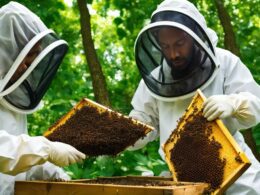Grapes, with their juicy clusters of fruit, have been cultivated for millennia to make wine, raisins, and other delicious treats. However, there exists a persistent misconception among some that grapes grow on trees. In this article, we will explore the truth behind the growth of grapevines and address the age-old question: Do grapes really grow on trees?
The Truth About Grapevines
Grapevines, belonging to the Vitis genus, are fascinating plants with a unique climbing habit. Unlike trees, grapevines have flexible canes that twine around structures or supports, allowing them to reach upward for optimal sunlight and air circulation. This enables grapevines to thrive in various conditions, adapting to different environments. Their ability to climb is a defining characteristic that sets them apart from traditional tree growth.
The remarkable feature of grapevines lies in their fruit production. These vines possess the incredible ability to produce clusters of grapes in different sizes, colors, and flavors. From juicy red grapes to luscious green ones, their diversity is a testament to the botanical distinctions within the Vitis genus. It is through these bountiful clusters of grapes that we can truly appreciate the wonders of grapevine cultivation.
Dispelling the common myth that grapes grow on trees is crucial in understanding the true nature of grapevines. By recognizing their climbing habit and their unique fruit production, we gain a deeper appreciation for the botanical truth behind the growth of grapes. It is through this knowledge that we can truly grasp the beauty and intricacies of grapevine cultivation.
Next, let’s explore the annual life cycle of grapevines and the essential factors that contribute to their growth and development.
The Annual Life Cycle of Grapevines
Grapevines undergo a fascinating annual life cycle that encompasses various stages, each crucial to the growth and development of these bountiful fruits. Understanding this cycle sheds light on the intricate process of grapevine cultivation and introduces the importance of trellising and support systems in optimizing grape production.
Dormancy: During the winter months, grapevines enter a state of rest called dormancy. This period allows the vines to conserve energy, withstand colder temperatures, and prepare for the upcoming growth season.
Budbreak: As spring arrives and temperatures rise, grapevines awaken from their dormant state. This phase is known as budbreak, where new shoots emerge from the dormant buds. These shoots gradually develop, eventually giving rise to leaves and clusters of grapes.
Flowering: With the onset of warmer weather, grapevines enter the flowering stage. Delicate flowers emerge from the newly formed shoots, attracting pollinators such as bees and enabling fertilization. Successful pollination is essential for fruit set and subsequent grape production.
Fruit Set: After successful pollination, the fertilized flowers develop into small grape clusters. This phase, known as fruit set, marks the beginning of the grape’s journey towards ripening.
Ripening: Under the nurturing rays of the sun, the grape clusters begin to ripen. As the grapes mature, their sugar content increases, flavors develop, and colors transform. This is the time when vineyard managers closely monitor and assess the grapes’ readiness for harvest.
Leaf Fall: As autumn sets in, grapevines prepare for winter dormancy by shedding their leaves. Leaf fall allows the vines to conserve energy, redirect nutrients to the roots, and protect themselves from freezing temperatures.
Throughout this annual life cycle, trellising and support systems play a vital role. Grapevines rely on trellises or support structures to guide their growth, optimize sunlight exposure, and facilitate essential tasks such as pruning and training. These systems also aid in disease prevention, as proper airflow helps keep the vines healthy and robust.
By understanding the annual life cycle of grapevines and the importance of trellising and support systems, vineyard managers and enthusiasts can ensure optimal grape production and quality. The interplay of nature, vine physiology, and cultivated techniques harmonize to bring forth the vibrant grapes that delight our taste buds.
Are Grapes Considered a Vascular Plant like Ferns?
Yes, like ferns, grapes are also considered a vascular plant due to their complex system of ferns vascular tissue. This tissue allows for the transport of water, nutrients, and sugars throughout the plant, making grapes a part of the vast group of vascular plants found in nature.
Conclusion
Grapes do not grow on trees but on grapevines, which are distinct plants with a climbing habit. This botanical truth may come as a surprise to those who have long held the misconception that grapes grow on trees. The misconception likely stems from historical depictions and cultural practices, as well as the observation of grape clusters hanging from vines high above the ground.
Understanding the historical origins of this misconception is crucial in dispelling it. Throughout history, grapes have been associated with abundance, fertility, and indulgence. Paintings and artworks often depicted grapes hanging from branches, leading to the belief that they grow on trees. Additionally, cultural practices such as training grapevines along arbors or trellises can give the impression of grapes growing directly from trees. However, it is important to acknowledge the botanical truth that grapevines are separate entities from trees.
The cultural significance of grapes further contributes to the misconception. Grapes have been featured in religious rituals, mythologies, and culinary traditions of various cultures around the world. The prominence and desirability of grapes have solidified their reputation as a prized fruit, further cementing the misconception that they grow on trees.
By understanding the unique characteristics of grapevines and their reliance on trellising and support systems, we gain a deeper appreciation for the cultivation of these luscious fruits. The story of grapevines is equally rich and rewarding, intertwined with the art and science of grape growing. So, the next time you enjoy a delicious grape, remember that it grew on a vine, not a tree.









